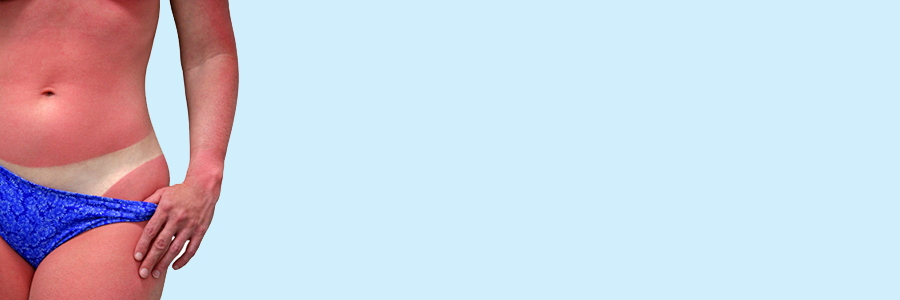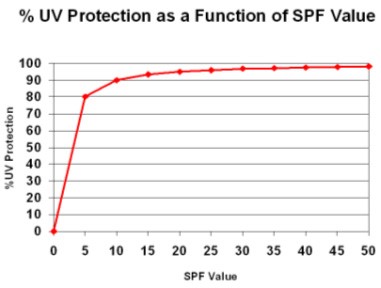SPF RATING SYSTEM AND UVB PROTECTION
Sunscreens are developed to provide protection against UV radiation, thereby helping to minimize the occurrence of skin cancers and photoaging. These sunscreen products are rated using the Sun Protection Factor (SPF) system, a numeric scale based upon the degree of protection they offer against the sun’s UV radiation.
SPF < 15: mild protection
SPF 15-30: moderate protection
SPF >30 (30+): high protection
How is SPF Determined?
A product’s SPF rating is determined under artificial conditions using a predetermined amount of sunscreen. The SPF is defined as the ratio of the amount of energy necessary to produce a minimal redness response (minimal erythema dose, MED) on skin covered by sunscreen, compared to the amount of energy necessary to produce the same degree of redness on unprotected skin. If it takes 35mJ/m2 of energy to produce 1 MED in unprotected skin and if it takes 350mJ/m2 of energy to produce 1 MED after applying a sunscreen, the sun protection factor (SPF) of that sunscreen is 10.
Energy needed to produce MED with sunscreen = 350 mJ/cm2 = SPF 10
Energy needed to produce MED without sunscreen 35 mJ/cm2
SPF Only Measures UV-B Protection
The SPF rating system is not a complete determination of a sunscreen’s ability to offer protection from all the sun’s harmful rays. The SPF only measures the protection provided against UVB radiation (290-320nm); it does not measure protection against UVA radiation (320-400nm). At this time the FDA does not require that a sunscreen offer UVA protection, nor does it require any official rating system for UVA protection. As a result, until very recently, the vast majority of sunscreens have been formulated to provide UVB protection, with little attention paid to offering quality UVA protection.
SPF = UVB protection
Studies show that most consumers understand that the higher the SPF number, the more the product protects the skin. Unfortunately, studies also demonstrate that people have the mistaken notion that the higher the SPF number of the sunscreen they use, the longer they can stay – and will stay – in the sun. The amount of protection against UVB rays does not increase substantially with higher SPF values:
SPF 15 blocks 93.3% of UVB radiation — your skin absorbs 6.7% of what you’d absorb wearing nothing
SPF 30 blocks 96.7% of UVB radiation — your skin absorbs 3.3% of what you’d absorb wearing nothing
SPF 40 blocks 97.5% of UVB radiation — your skin absorbs 2.5% of what you’d absorb wearing nothing
SPF 45 blocks 97.8% of UVB radiation — your skin absorbs 2.2% of what you’d absorb wearing nothing
SPF 50 blocks 98% of UVB radiation — your skin absorbs 2% of what you’d absorb wearing nothing
SPF 60 blocks 98.3% of UVB radiation — your skin absorbs 1.7% of what you’d absorb wearing nothing
This graph illustrates UV protection. As the SPF increases above 30 there are only very small corresponding increases in protection.
Based upon this curve, we recommend that everyone always use a sunscreen with SPF 30 or more.
The Term “Broad Spectrum” Has Been Misleading
Sunscreens that do offer protection against UVB and UVA rays may be labeled “broad spectrum”, but this term (historically) has been loosely applied and therefore has often been misleading. Certainly the addition of any UVA protection is beneficial when compared to UVB protection alone. Until very recently, the amount of UVA protection in many so-called “broad spectrum” sunscreens was often minimal and only for short wave UVA (UVAII, 320nm-340nm) rays. Many of these so-called “broad spectrum” sunscreens provided very little coverage throughout the entire UVA spectrum (320-400nm). And subsequently, the use of a high SPF product wrongly allowed (encouraged) people to stay in the sun longer, with less burning, while they received more damaging UVA exposure.
In terms of popular products from a trusted and leading manufacturer, one of the biggest offenders of this labeling was Coppertone’s Water Babies. The label read SPF 45 and stated UVB and UVA protection. The ingredients however, provided mostly UVB protection with only a very small (negligible) amount of UVA protection. In the strictest sense, their labeling was not incorrect – BUT it certainly was misleading. So while many of you, as parents, used Water Babies on your children, thinking you were really protecting them…. You were just allowing them to stay in the sun longer and soak up more UVA radiation. I’m sure most individuals trusted that this was a superior product, and that everything was being done to provide the maximum protection possible for the children’s skin. Coppertone finally reformulated the Water Babies sunscreen. The SPF 50 product now contains the words ‘Extra UVA Protection’. The use of the word ‘Extra’ is a bit humorous in this situation. This illustrates, that as consumers, we can help ourselves by being more knowledgeable about sunscreens, and thereby feel more confident in the product we are using. But admittedly, this is certainly not straight forward.
A claim such as “broad spectrum” on a sunscreen label needs to be supported by evidence that the product provides significant and meaningful protection across the entire UVB and UVA spectrum. Because of a previous lack of FDA regulation, the term ‘broad spectrum’ has been used by manufacturers without any consistent meaning…when, instead, it should really be reserved for those products that provide quality protection between 290 – 400nm. Thankfully, the FDA now requires sunscreens to pass a ‘broad spectrum’ test before that claim can be printed on the product label. This test measures the “critical wavelength”, where sunscreens with a value > 370nm will be considered ‘broad spectrum’. This is nothing new to us and I have been promoting “critical wavelength” as an appropriate measure of broad spectrum coverage since the late 1990s. In the interest of providing our patients with adequate sun protection, all the sunscreens we have sold over the last decade have critical wavelengths > 370nm. You can read more about critical wavelength here.
The FDA sunscreen labeling requirements are discussed in more depth here.
SPF Has No Relation to UVA Protection
Although it is frequently assumed that highly-rated (>15) SPF products offer more UVA protection, this is not necessarily true. The sun protection provided by specific sunscreen products varies significantly depending upon the type of active sunscreen ingredient(s) used, the products chemical composition, and how that material is dispersed on the surface of the skin. In vivo exposure testing of a specific product is the only true way to document a sunscreen’s efficacy, and to determine its “substantivity” (the lasting effect of its protection). It is these properties that become important when one is perspiring or swimming.
Since the UVA rays are primarily responsible for tanning, UVA protection is an essential part of preventing increased skin pigmentation in response to sun exposure. But since the SPF rating system only addresses UVB protection, the SPF determination cannot be correlated with a product’s efficiency in preventing skin pigmentation. More simply, the SPF tells the consumer how much protection is provided to prevent a sun burn, but does not indicate how much protection is provided to prevent skin pigmentation. Sunscreens with a high SPF and a high level of UVA protection will have a similar level of protection against both sun burn and induced skin pigmentation. Sunscreens with a high SPF, but low level UVA protection, will prevent sun burn but are less able to prevent skin pigmentation.
Confused? Don’t Understand?
We recognize that this may all be very confusing. But we are happy to explain it to you. The more you understand, the better decisions you will make. We will be happy to answer your questions during your consultation, or just give us a call, 414-443-0033.



